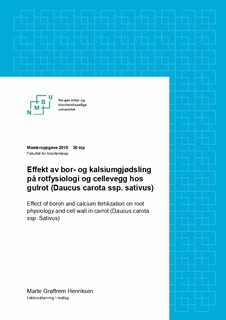| dc.contributor.author | Henriksen, Marte Grøftrem | |
| dc.date.accessioned | 2019-07-19T12:57:26Z | |
| dc.date.available | 2019-07-19T12:57:26Z | |
| dc.date.issued | 2019 | |
| dc.identifier.uri | http://hdl.handle.net/11250/2606005 | |
| dc.description.abstract | Gulrot er en mye brukt grønnsak, og for å oppnå best mulig lagringsevne og en høy norskandel på markedet er det avgjørende at den ikke har svakheter. Svakheter i cellevegg kan føre til lavere kvalitet og økt smitte av sykdommer ved innlagring og på lager, og dermed større matsvinn. Patogener fører til stort svinn under lagring, og tuppråte er et økende problem. En hypotese er at tuppråte kommer av svakheter i cellevegg, der bor (B) og kalsium (Ca) spiller en viktig strukturell rolle.
Hovedmålet med denne oppgaven var å se på hvordan ulike nivåer av B- og Ca-gjødsling påvirker fysiologiske egenskaper hos gulrot (Daucus carota ssp sativus), med hovedfokus på cellevegg.
Gjødslingsforsøk med seks ulike kombinasjoner av (B) og (Ca) ble gjennomført under kontrollerte forhold. Lengde, diameter (topp og spiss), tørrstoffprosent (topp og spiss), bladareal, tørrstoffprosent bladverk, spenning (topp og spiss), B-innhold (topp og spiss) og Ca-innhold (topp og spiss) ble undersøkt. I tillegg ble antall løse/separerte cellevegger undersøkt i konfokalmikroskop.
Det ble ikke funnet signifikante forskjeller på lengde, diameter, tørrstoffprosent bladverk, bladareal eller spenning mellom de ulike B- og Ca-nivåene. B-innholdet i røttene var som ventet høyere i røttene ved høy B-gjødsling, både i toppen og spissen. I toppen ble høyest B-innhold funnet ved høy B og lav Ca, og i spissen ved høy B og middels Ca. Variasjonen mellom B-innhold ved høy B-tilførsel og lav, middels og høy Ca kan tyde på at Ca har en begrensende rolle hva gjelder gulrotas opptak av B.
Ca-innholdet i gulrøttene varierte noe, men ikke i så stor grad som B-innholdet. Det samme gjelder tørrstoffprosenten til gulrøttene. Denne var høyest ved høy B og høy Ca, både i toppen og spissen.
Andelen løse/separerte cellevegger varierte stort mellom B- og Ca-nivåene. Det var tydelig lavere andel løse/separerte cellevegger ved røttene ved høy B. Aller lavest var det ved høy B og middels Ca, både i topp og spiss.
Ut fra forsøket er det tydelig at B- og Ca-gjødsling har effekt på kvaliteten til gulrot, særlig på andel løse/separerte cellevegger.
Lignende forsøk bør gjennomføres i større skala, muligens med større forskjell i B- og Ca-nivå for å se om andre forskjeller kommer tydeligere frem. | nb_NO |
| dc.description.abstract | Carrot is a popular vegetable, known for its good storability. The storability is reduced when carrot has physiological weaknesses and poor quality at harvest. Weakness in the cell wall leads to poor quality and increase in pathogen infections, reduction in storability and an increase in food loss. Tip rot is an increasing problem in carrot storage. A hypothesis is that tip rot is related to weakness inn cell walls, where boron (B) and calcium (Ca) have important structural roles.
The aim of this master thesis was to investigate how different levels of Boron and Calcium fertilization influence physiological properties in carrot (Daucus carota ssp sativus), with main focus on cell walls.
A fertilizer experiment with six different combinations of boron and calcium was conducted under controlled conditions. The length of the roots, the diameter (top and tip), dry matter content (top and tip), leaf area index, dry matter content of the leaves, compression strength (top and tip), Bcontent (top and tip) and Ca-content (top and tip) was registered. In addition, the number of loose/separated cell walls studied using a laser confocal microscope.
There were no significant differences in length, diameter, dry matter content of the leaves, leaf area index or compression strength between the different B- an Ca-levels used. The B-content of the roots was higher in the roots with the high B fertilizer levels, both in the top and tip. In the top of the root the highest B-content was found in roots fertilized with high levels of B and low Ca levels, whereas in the tip of the roots the highest B-content was found in roots receiving high B and medium Ca levels. The variation in B-content in roots fertilized with high B and low, medium and high Ca levels suggest that Ca has a restricting role in B uptake. There were also differences in Ca-content, but not as significant as the B-content. Dry matter of the roots also varied but was higher in carrots fertilized with high B levels combined with high Ca levels.
The number of loose/separated cell walls varied between the different B- and Ca- fertilizer levels. Lowest number was found when using the high B levels, whereas the absolute lowest number of loose/separated cell walls was found for high B combined with medium Ca levels both in the top and tip of the root.
From this experiment it is clear that B- and Ca-fertilizer affects carrots, especially regarding the amount of loose/separated cell walls.
Similar experiments should be done in a larger scale and include higher levels of B- and Ca fertilization, to see if more or larger differences appear. | nb_NO |
| dc.language.iso | nob | nb_NO |
| dc.publisher | Norwegian University of Life Sciences, Ås | nb_NO |
| dc.rights | Attribution-NonCommercial-NoDerivatives 4.0 Internasjonal | * |
| dc.rights.uri | http://creativecommons.org/licenses/by-nc-nd/4.0/deed.no | * |
| dc.title | Effekt av bor- og kalsiumgjødsling på rotfysiologi og cellevegg hos gulrot (Daucus carota ssp. sativus) | nb_NO |
| dc.title.alternative | Effect of boron and calcium fertilization on root physiology and cell wall in carrot (Daucus carota ssp. Sativus) | nb_NO |
| dc.type | Master thesis | nb_NO |
| dc.description.localcode | M-LUN | nb_NO |

